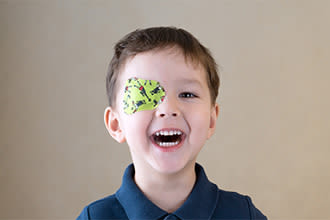Amblyopia: Lazy eye symptoms and treatment

Amblyopia is a developmental vision disorder in which an eye fails to achieve normal visual acuity, even with prescription glasses or contact lenses.
Also called lazy eye, amblyopia usually begins during infancy and early childhood. In most cases, only one eye is affected but in some cases, reduced visual acuity can occur in both eyes.
Particularly if lazy eye is detected early in life and treated promptly, reduced vision can be minimised. If left untreated, lazy eye can cause severe visual disability in the affected eye.
According to a recent analysis of 73 studies published in English, the pooled estimate of the prevalence of amblyopia worldwide is 1.75 percent of the total population.
The prevalence of amblyopia varies in different parts of the world, with the highest prevalence in European countries (3.67 percent).
Amblyopia signs and symptoms
As amblyopia is typically a problem of infant vision development, symptoms of the condition can be difficult to discern.

You can help your child accept wearing an eye patch for lazy eye by making it fun.
However, a common cause of amblyopia is strabismus, so if you notice your baby or young child has crossed eyes or some other apparent eye misalignment, visit an optometrist immediately — preferably one who specialises in children's vision.
Another clue that your child may have amblyopia is if he or she cries or fusses when you cover one eye.
You can try this simple screening test at home, simply cover and uncover your child's eyes, (one eye at a time), when he or she is performing a visual task, such as watching television.
If your child is not bothered when one eye is covered but objects when the other eye is, this may suggest that the eye you have covered is the "good" eye, and that the uncovered eye is amblyopic, causing blurred vision.
Remember this simple screening test is not a substitute for a comprehensive eye examination.
Have your child's eyes examined as recommended to make sure he or she has normal vision in both eyes and that the eyes function together properly as a team.
What causes amblyopia?
There are three types of amblyopia, based on the underlying cause:
Strabismic amblyopia
Strabismus is the most common cause of amblyopia. To avoid double vision caused by poorly aligned eyes, the brain ignores the visual input from the misaligned eye, leading to amblyopia in that eye (the "lazy eye"). This type of amblyopia is called strabismic amblyopia.
Refractive amblyopia
Sometimes, amblyopia is caused by unequal refractive errors in the two eyes, despite perfect eye alignment. For example, one eye may have significant uncorrected short sightedness or long sightedness, while the other eye does not.
Or one eye may have significant astigmatism and the other eye does not. In such cases, the brain relies on the eye that has less uncorrected refractive error and "tunes out" the blurred vision from the other eye, this disuse causes amblyopia in that eye.
This type of amblyopia is called refractive amblyopia (or anisometropic amblyopia).
Deprivation amblyopia
This is lazy eye caused by something that obstructs light from entering and being focused in a baby's eye, such as a congenital cataract. Prompt treatment of congenital cataracts is necessary to allow normal visual development to occur.
Amblyopia treatment
In some cases of refractive amblyopia, normal vision can be achieved simply by fully correcting the refractive errors in both eyes with glasses or contact lenses. Usually, however, at least some patching of the "good" eye is needed to force the brain to pay attention to the visual input from the amblyopic eye and enable normal vision development to occur in that eye.
Treatment of strabismic amblyopia may involve strabismus surgery to straighten the eyes, followed by eye patching and often some form of vision therapy (also called orthoptics) to help both eyes work together equally as a team.
Patching may be required for several hours each day or even all day long and may continue for weeks or months.
If you have a lot of trouble with your child taking the patch off, you might consider a specially designed prosthetic contact lens that prevents light from entering the good eye but does not affect your child's appearance.
Though prosthetic lenses are more costly than a simple eye patch and require a contact lens exam and fitting, they can work wonders in difficult cases of amblyopia treatment when compliance with eye patching is poor.
In some children, atropine eye drops have been used to treat amblyopia instead of an eye patch. One drop is placed in your child's good eye each day (your optometrist will instruct you). Atropine blurs vision in the good eye, which forces your child to use the eye with amblyopia more, to strengthen it.
One advantage of using atropine eye drops is that it doesn't require your constant vigilance to make sure your child wears the patch.
In one large study of 419 children younger than 7 years of age with amblyopia ranging from 20/40 (6/12) to 20/100 (6/30) prior to treatment, atropine therapy produced comparable results to eye patching (though improvement in visual acuity in the amblyopic eye was slightly greater in the patching group). As a result, some previously sceptical optometrists are using atropine as their first choice for amblyopia treatment over patching.
Be aware that atropine does have side effects that should be considered: light sensitivity (because the eye's pupil is constantly dilated), flushing and possible paralysis of the ciliary muscle after long-term atropine use, which could affect the eye's accomodation, or ability to change focus.
Help for older children and adults with lazy eye
For years, experts believed that if amblyopia treatment was not initiated very early in life, no improvement in visual acuity was possible. The critical period for intervention was said to be around age 8.
It now appears that older children and even adults with long-standing lazy eye can benefit from amblyopia treatment using computer programs that stimulate neural changes leading to improvements in visual acuity and contrast sensitivity.
Computer programs to treat lazy eye also are available and may be used by optometrists who specialise in children's vision and vision therapy.
Early detection and treatment are important
Though modern amblyopia treatments might improve vision in older children and adults, most experts agree that early detection and treatment of lazy eye is preferred for normal visual development and the best visual outcomes from amblyopia treatment.
Amblyopia will not go away on its own, and untreated lazy eye can lead to permanent visual problems. If later in life your child's stronger eye develops disease or is injured, he or she will depend on the poor vision of the amblyopic eye, so it is best to treat amblyopia early on.
In some cases, uncorrected refractive errors and amblyopia in young children can lead to behaviours that seem to indicate developmental or other disorders when the problem is purely visual.
Page published on Monday, 16 March 2020






